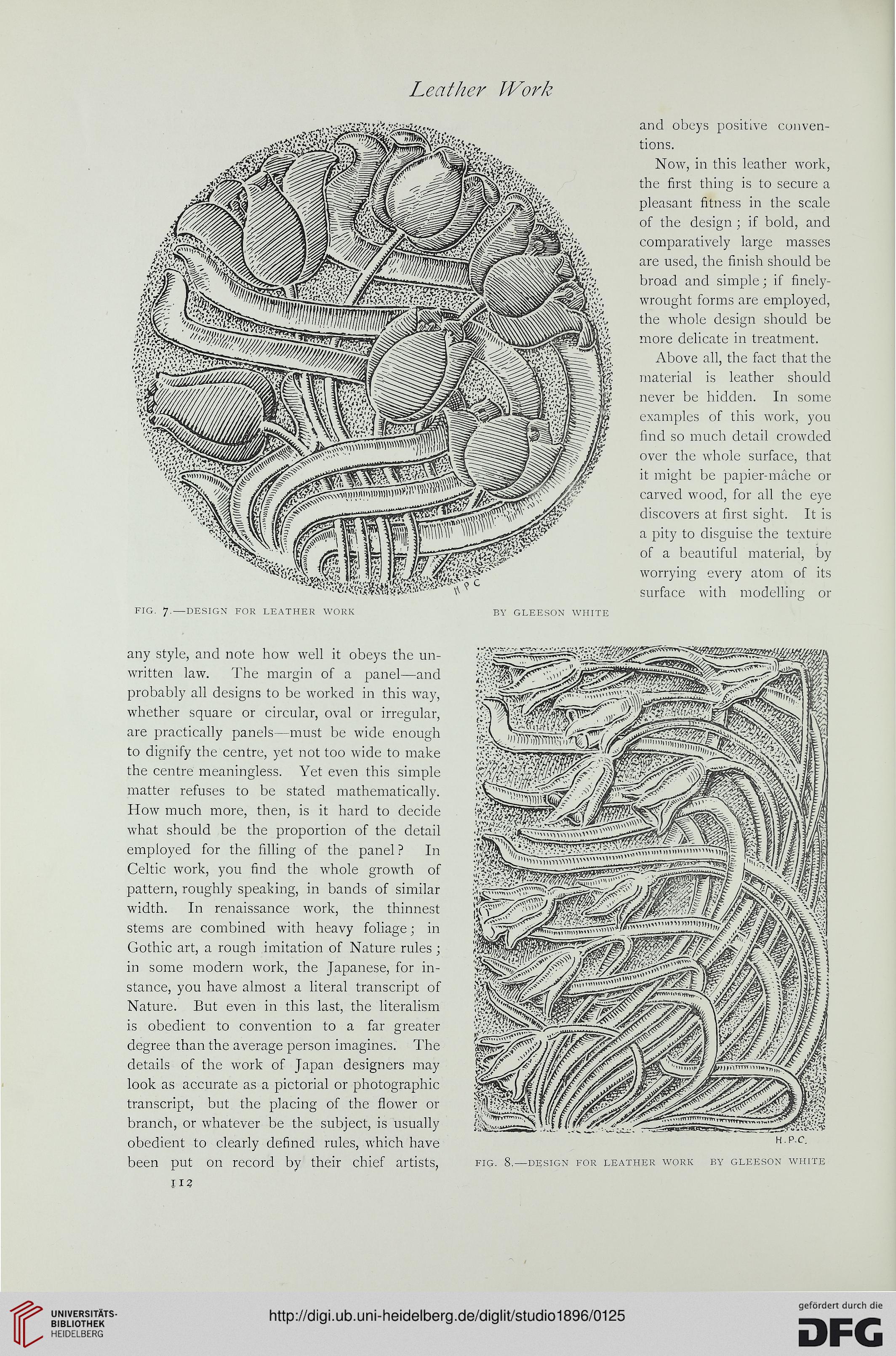Leather Work
^*^^«^^BBsaSKgSSl<t. tions
and obeys positive conven-
*^;mmm^^' c surface with modellin
fig. 7.—design for leather work by gleeson white
Now, in this leather work,
the first thing is to secure a
pleasant fitness in the scale
of the design ; if bold, and
comparatively large masses
are used, the finish should be
broad and simple; if finely-
wrought forms are employed,
the whole design should be
more delicate in treatment.
Above all, the fact that the
material is leather should
never be hidden. In some
examples of this work, you
find so much detail crowded
over the whole surface, that
it might be papier-mache or
carved wood, for all the eye
discovers at first sight. It is
a pity to disguise the texture
of a beautiful material, by
worrying every atom of its
or
b
any style, and note how well it obeys the un-
written law. The margin of a panel—and
probably all designs to be worked in this way,
whether square or circular, oval or irregular,
are practically panels—must be wide enough
to dignify the centre, yet not too wide to make
the centre meaningless. Yet even this simple
matter refuses to be stated mathematically.
How much more, then, is it hard to decide
what should be the proportion of the detail
employed for the filling of the panel ? In
Celtic work, you find the whole growth of
pattern, roughly speaking, in bands of similar
width. In renaissance work, the thinnest
stems are combined with heavy foliage; in
Gothic art, a rough imitation of Nature rules ;
in some modern work, the Japanese, for in-
stance, you have almost a literal transcript of
Nature. But even in this last, the literalism
is obedient to convention to a far greater
degree than the average person imagines. The
details of the work of Japan designers may
look as accurate as a pictorial or photographic
transcript, but the placing of the flower or
branch, or whatever be the subject, is usually
obedient to clearly defined rules, which have h.p.c.
been put on record by their chief artists, fig. 8.—design for leather work by gleeson white
ii?
^*^^«^^BBsaSKgSSl<t. tions
and obeys positive conven-
*^;mmm^^' c surface with modellin
fig. 7.—design for leather work by gleeson white
Now, in this leather work,
the first thing is to secure a
pleasant fitness in the scale
of the design ; if bold, and
comparatively large masses
are used, the finish should be
broad and simple; if finely-
wrought forms are employed,
the whole design should be
more delicate in treatment.
Above all, the fact that the
material is leather should
never be hidden. In some
examples of this work, you
find so much detail crowded
over the whole surface, that
it might be papier-mache or
carved wood, for all the eye
discovers at first sight. It is
a pity to disguise the texture
of a beautiful material, by
worrying every atom of its
or
b
any style, and note how well it obeys the un-
written law. The margin of a panel—and
probably all designs to be worked in this way,
whether square or circular, oval or irregular,
are practically panels—must be wide enough
to dignify the centre, yet not too wide to make
the centre meaningless. Yet even this simple
matter refuses to be stated mathematically.
How much more, then, is it hard to decide
what should be the proportion of the detail
employed for the filling of the panel ? In
Celtic work, you find the whole growth of
pattern, roughly speaking, in bands of similar
width. In renaissance work, the thinnest
stems are combined with heavy foliage; in
Gothic art, a rough imitation of Nature rules ;
in some modern work, the Japanese, for in-
stance, you have almost a literal transcript of
Nature. But even in this last, the literalism
is obedient to convention to a far greater
degree than the average person imagines. The
details of the work of Japan designers may
look as accurate as a pictorial or photographic
transcript, but the placing of the flower or
branch, or whatever be the subject, is usually
obedient to clearly defined rules, which have h.p.c.
been put on record by their chief artists, fig. 8.—design for leather work by gleeson white
ii?




